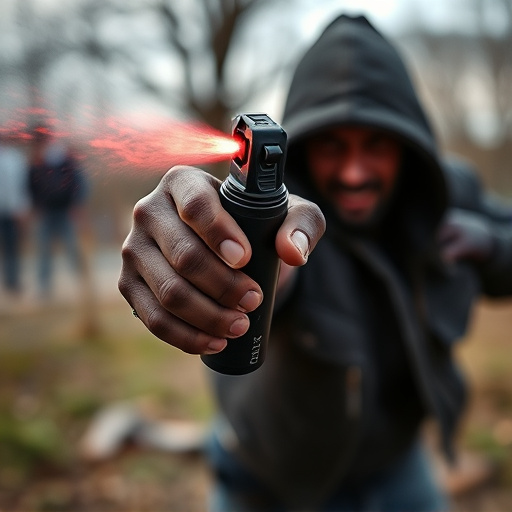TL;DR:
Understanding pepper spray exposure symptoms, including eye irritation, breathing difficulty, and skin redness, is crucial for well-being. Immediate action after exposure is key: remove contaminated clothing, rinse eyes with water for 15+ minutes, seek fresh air, and wash affected skin areas. Document symptoms and seek medical attention promptly, especially for severe or persistent cases. Long-term care involves monitoring symptoms and consulting healthcare professionals. Prevention includes protective gear and first aid training. Learn how to treat pepper spray exposure effectively to avoid long-term health complications.
“Riot control inflammatory spray canisters, also known as pepper spray, pose significant risks when exposed. This article delves into understanding pepper spray exposure, its causes, and symptoms, offering crucial insights for immediate post-exposure steps. We explore long-term care strategies and prevention tactics to mitigate the effects of such incidents. Learn how to recognize and address pepper spray exposure, with a focus on effective treatment methods, ensuring safety and rapid recovery. Discover essential tips on ‘How to Treat Pepper Spray Exposure’ for those affected.”
- Understanding Pepper Spray Exposure: Causes and Symptoms
- Immediate Steps After Pepper Spray Contact
- Long-term Care and Prevention Strategies
Understanding Pepper Spray Exposure: Causes and Symptoms
Understanding Pepper spray exposure is crucial, as it can have significant effects on an individual’s health and well-being. When exposed to pepper spray, which is a type of inflammatory spray canister used for riot control, people may experience a range of symptoms. These typically include eye irritation, tearing, redness, and pain, often described as a burning sensation. Inhalation can lead to coughing, difficulty breathing, and a stinging feeling in the nose and throat. Skin contact causes itching, redness, and temporary numbness or tingling.
Knowing how to treat pepper spray exposure is essential for minimizing discomfort and potential long-term effects. The first step is to move to a safe area away from the source of the spray. Then, gently flush eyes with clean water for at least 15 minutes to reduce irritation. If inhaled, seek fresh air immediately and consider using an inhaler if available. For skin contact, remove any contaminated clothing and thoroughly wash the affected areas with soap and warm water. In severe cases or if symptoms persist, medical attention should be sought.
Immediate Steps After Pepper Spray Contact
If you’ve been exposed to pepper spray, the first steps are crucial for mitigating discomfort and potential long-term effects. Upon contact, immediately remove any clothing or accessories that may have absorbed the spray, being careful not to rub or wipe the affected area, as this can spread the irritants further. Rinse the eyes thoroughly with clean water for at least 15 minutes if they were exposed, as this helps flush out the chemicals. If breathing is difficult due to nasal or throat irritation, move to an area with fresh air and try to calm down to ease panting.
For skin exposure, gently wash the affected areas with mild soap and water, avoiding harsh cleansers. Apply a cold compress or ice pack wrapped in a towel to help reduce pain and swelling. If possible, document any symptoms, including photos of rashes or blisters, as this can be valuable for medical professionals. Seeking immediate medical attention is recommended, especially if symptoms persist or worsen, to ensure proper How to Treat Pepper Spray Exposure and prevent any long-lasting health issues.
Long-term Care and Prevention Strategies
After any exposure to riot control inflammatory spray, it’s crucial to initiate immediate and thorough washing of the affected area. This involves rinsing with plenty of clean water for at least 15-20 minutes, ensuring that all areas including eyes, skin, clothing, and shoes are thoroughly cleaned. If the spray has come into contact with eyes, seeking medical attention is recommended to prevent potential damage.
Long-term care involves monitoring symptoms like irritation, redness, or difficulty breathing. In case of persistent issues, consulting a healthcare professional becomes essential. Prevention strategies include wearing protective gear such as goggles and clothing that covers exposed skin when in areas where pepper spray might be used. Additionally, learning how to treat pepper spray exposure through first aid training can equip individuals with the knowledge to manage potential incidents effectively.
Pepper spray exposure can be a frightening experience, but with swift action and proper long-term care, you can minimize its impact. Understanding the causes and symptoms is key to knowing how to treat pepper spray exposure effectively. Following immediate steps after contact, such as removing contaminated clothing and flushing the affected area, can help alleviate symptoms. Additionally, implementing prevention strategies like regular hand washing and using protective gear when in high-risk areas, will significantly reduce future risks. By heeding these guidelines, you’ll be better equipped to handle pepper spray exposure and ensure your safety.
